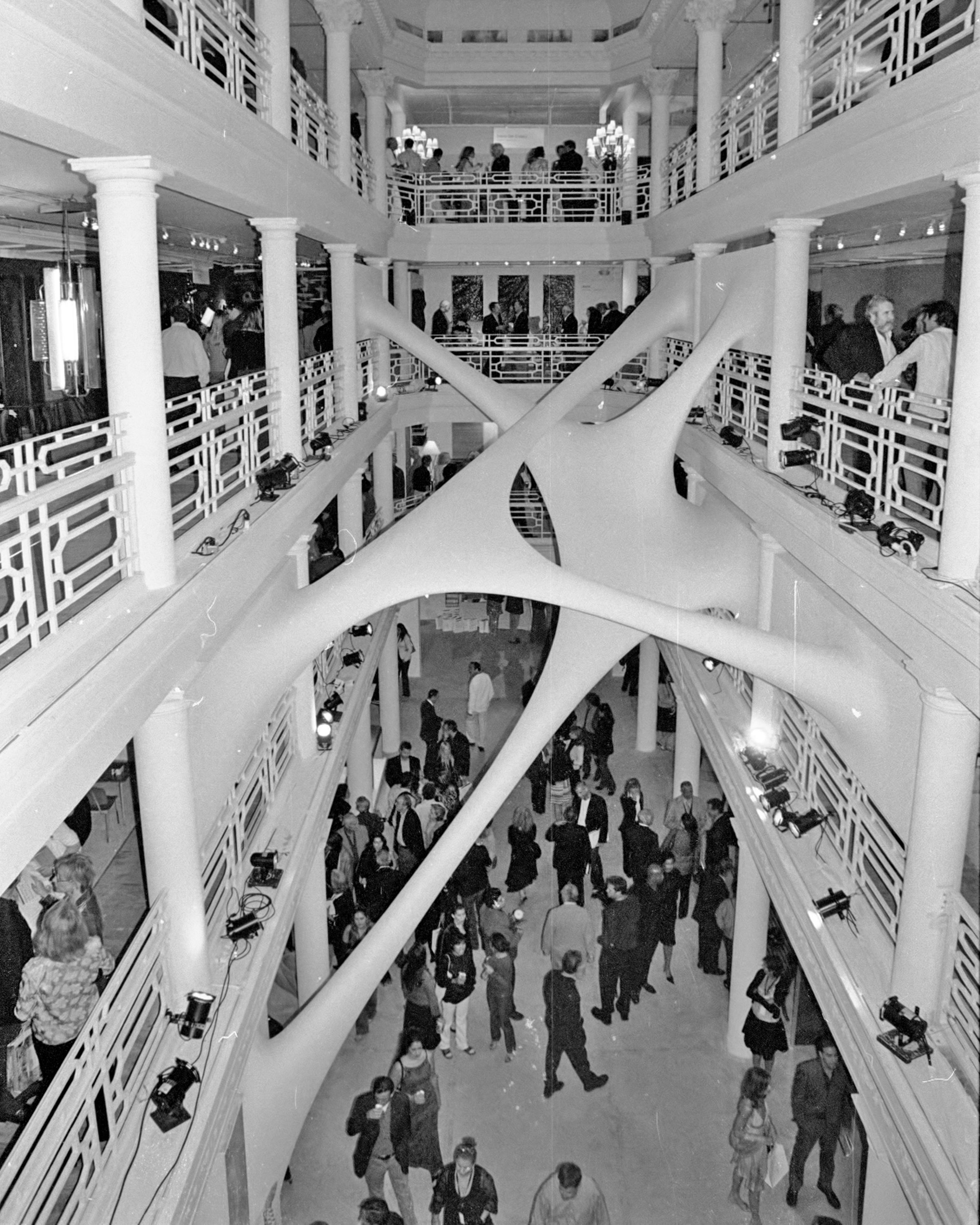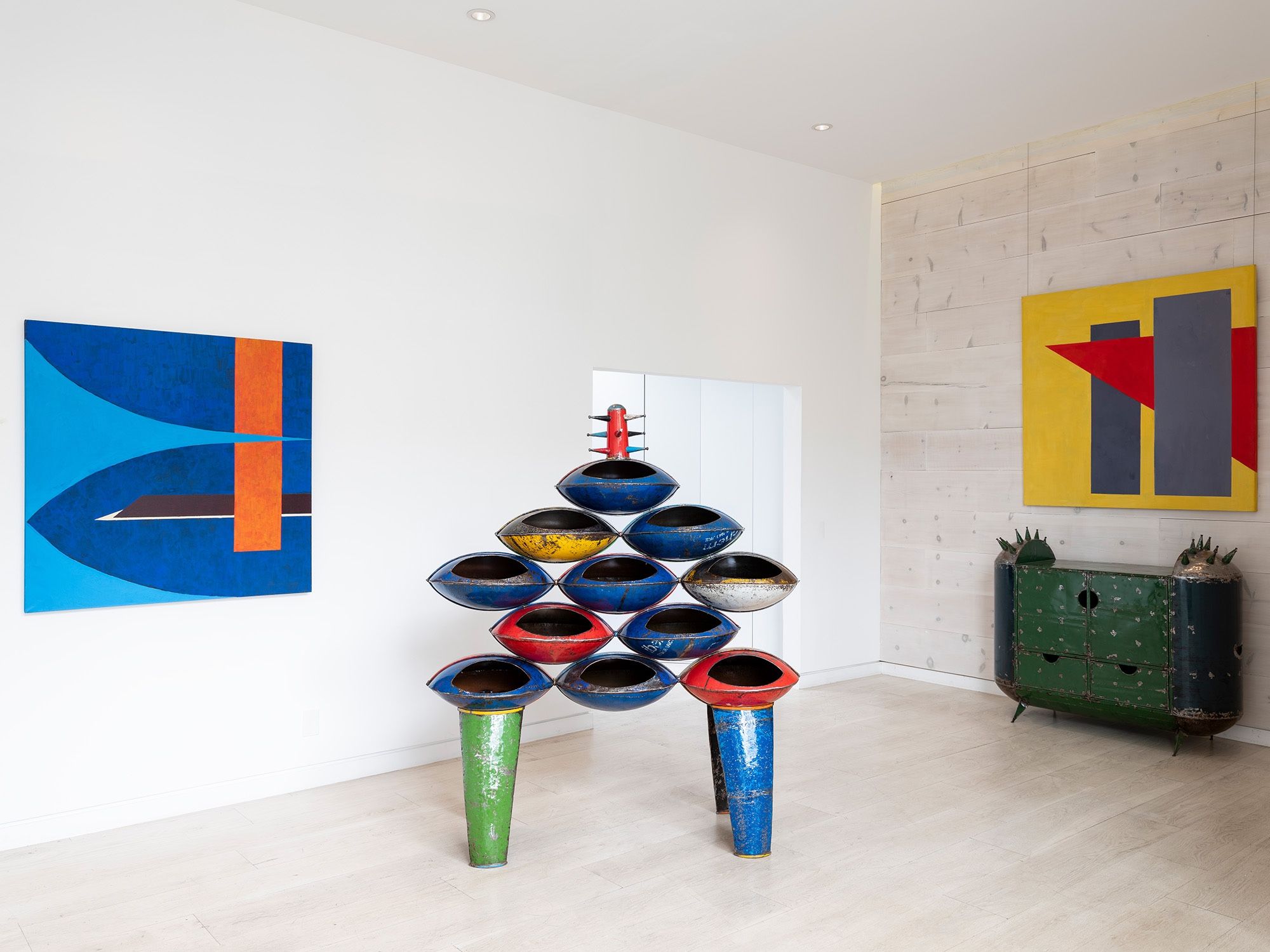IN THE MIX OCTOBER 21 2021
by Design Miami
Design Miami's Wava Carpenter and Anna Carnick guest curate a timely exhibition at Carpenters Workshop Gallery in New York
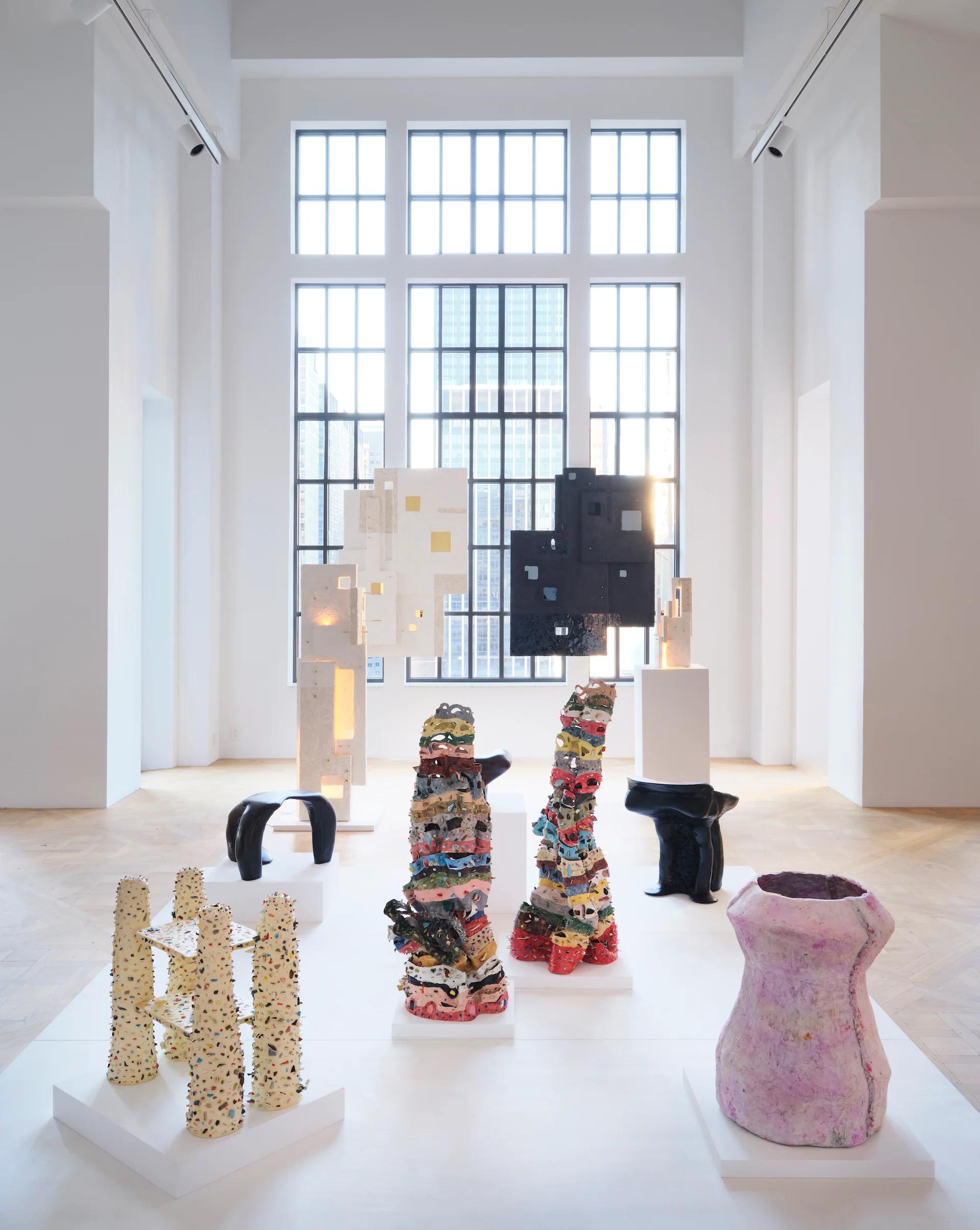
THE NEW GUARD: STORIES FROM THE NEW WORLD AT CARPENTERS WORKSHOP GALLERY IN NEW YORK
Photo © Carpenters Workshop Gallery
Carpenters Workshop Gallery in New York has just opened The New Guard: Stories from The New World, an exhibition spotlighting seven outstanding emerging talents from the US and Caribbean. The show is guest-curated by Anava Projects—the creative agency led by Design Miami’s very own Anna Carnick and Wava Carpenter—who collaborated on the project with the gallery's director Ashlee Harrison.
To mark the occasion, we're sharing Carnick and Carpenter's curatorial essay. Scroll to learn more about the timely thread that runs through the work commissioned for the show.
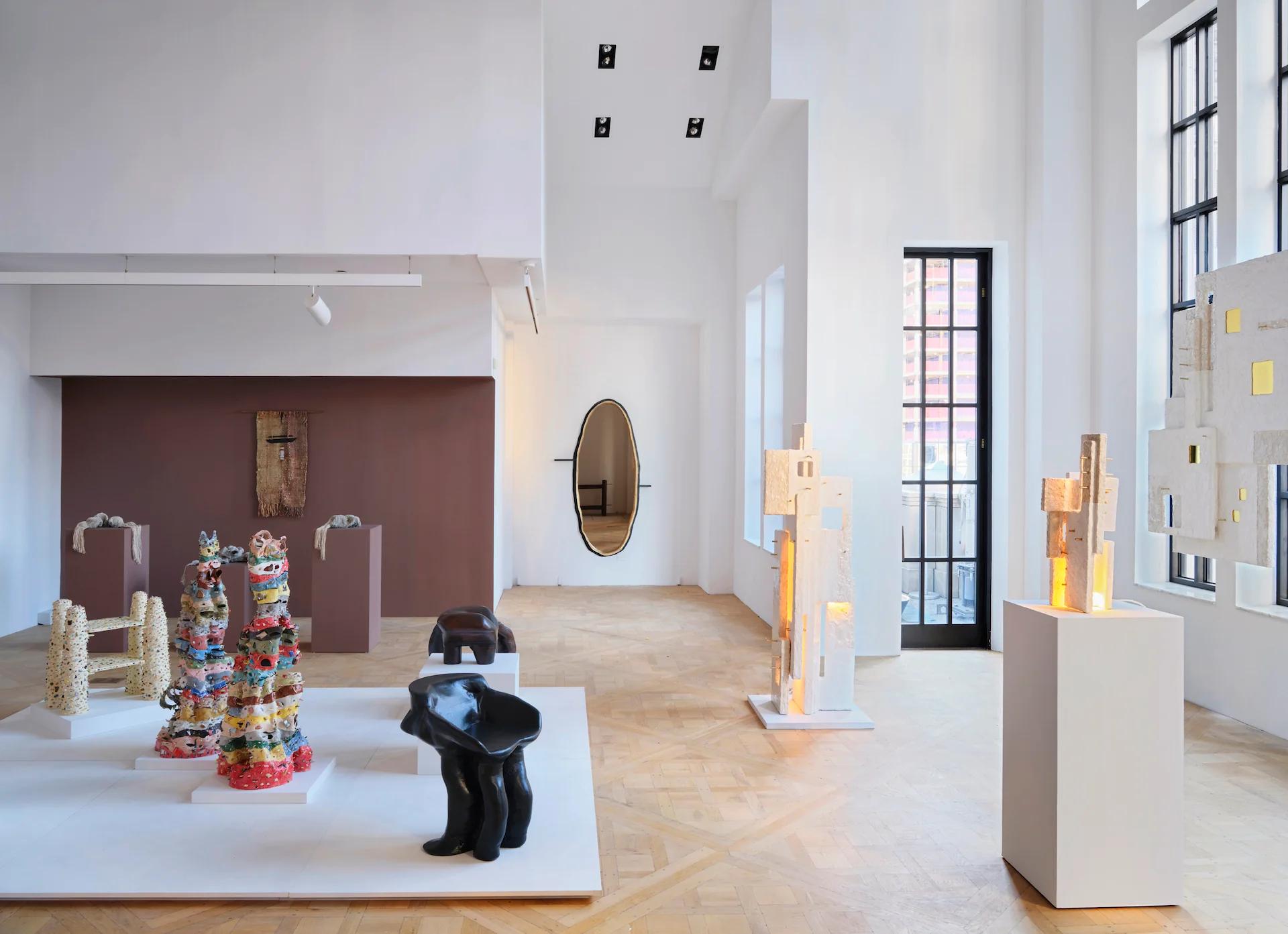
THE NEW GUARD: STORIES FROM THE NEW WORLD AT CARPENTERS WORKSHOP GALLERY IN NEW YORK
Photo © Carpenters Workshop Gallery
Ways of Seeing
“When we reject the single story, when we realize there is never a single story about any place, we regain a kind of paradise.” —Chimamanda Ngozi Adichie, novelist
“Stories bring us together; untold stories keep us apart.” —Elif Shafak, political scientist and activist
“Being American is more than the pride we inherit, it’s a past we step into and how we repair it.” —Amanda Gorman, poet
When Carpenters Workshop Gallery asked us to curate an exhibition of emerging designers in America, we were honored, recognizing that the project would be seen as a departure from the gallery’s esteemed, historically European-based program. We also understood that this show offered a rare, exciting opportunity for unique design voices on this side of the pond to tell American design stories not often heard in broader, Euro-centric international conversations.
Despite the long legacy of open transatlantic exchange, the design cultures of Europe and the US remain distinct, impacted by discrepancies in educational systems, institutional support structures, media environments, and business models. In Europe, the landscape that designers traverse is more abundant, cooperative, and cohesive. In America, designers typically must forge their own singular paths through a rocky terrain, one that favors the commercial over the cultural and weeds out many would-be creatives in the few crucial years after school. This is not to say that design in one place or the other is innately better—incredible design can be found in every corner of the world. The point is that design in the American context is most fully understood in light of its intrepid, entrepreneurial, autonomous spirit.
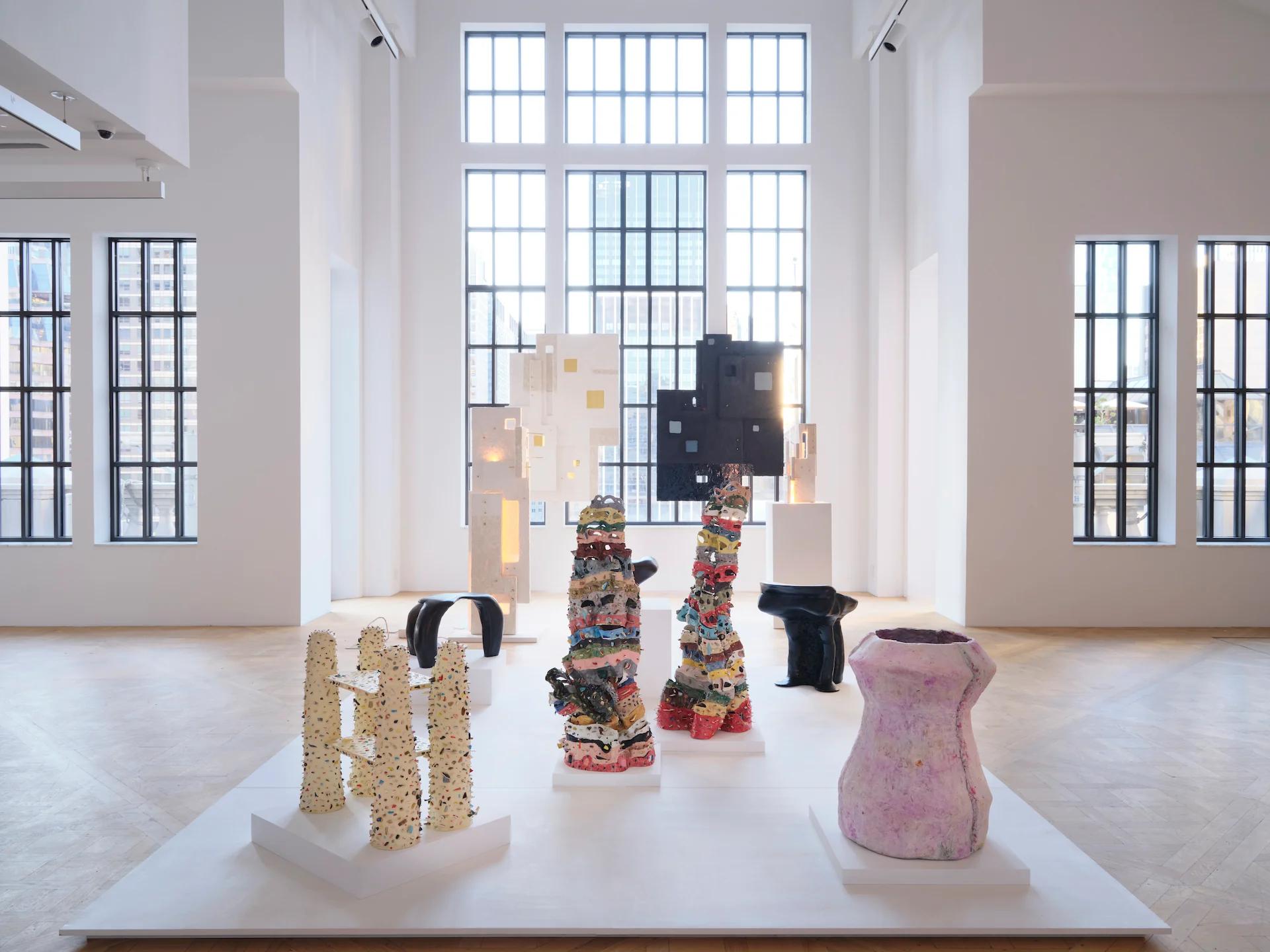
THE NEW GUARD: STORIES FROM THE NEW WORLD AT CARPENTERS WORKSHOP GALLERY IN NEW YORK
Photo © Carpenters Workshop Gallery
As an ensemble, the independent talents invited to participate in Stories for the New World offer an illuminating snapshot of the rising generation of designers in and around the United States in 2021. Though geographically scattered and influenced by a range of personal experiences, they each approach their preferred materials with a fresh perspective to create hand-wrought, highly sculptural, narratively driven forms, embracing an idiosyncrasy that stands in defiance of the prevailing commercialism of design culture in America. The resulting exhibition speaks to the now beyond borders, emphasizing design as autobiography, designers as raconteurs, and objects as poetic artifacts of the human experience.
At this moment, when people across the globe are hungry for a feeling of connection—in a time marred by inequity, division, and disruptions—the young designers presented here, each in their own way, answer our collective call by relating something of themselves through the objects they create. In communicating stories of identity, heritage, and place, the exceptional objects commissioned for this exhibition resonate with our world in flux, with the near universal hope that communing with something greater than ourselves can bridge the cleavages. Every object has its story, but no single story defines design in this region. It is that complexity that provides the source of “the New World’s” power and magic.

MARYAM TURKEY
Photo © Carpenters Workshop Gallery
Maryam Turkey: Between Rise & Fall
New York artist Maryam Turkey works across media, creating objects—usually by hand—that run the gamut from functionalist to expressionist, always with an approach that is at once research-driven and intuitive. For Turkey, context is everything; the narratives embedded in her works are designed to meet the moment.
With her Between Rise & Fall collection, Turkey has constructed a hybrid, imagined cityscape, one inspired by distant and recent memories of the two metropolises that have shaped her life: Baghdad, where she was raised, and New York, where she moved for school following her family’s immigration to the US as refugees in 2009. Handcrafted in paper-pulp, the forms evoke vacant buildings, both Baghdadi homes abandoned amid war and the empty skyscrapers—some partially constructed and others complete—of New York’s silenced financial district during the height of the pandemic. As one walks around her cityscape, light and shadows shift, calling to mind passing clouds or the narrow shafts of light between Manhattan’s dense vertical skyline. For Turkey, these architectural remnants symbolize the seemingly endless human cycle of building, destroying, and rebuilding.
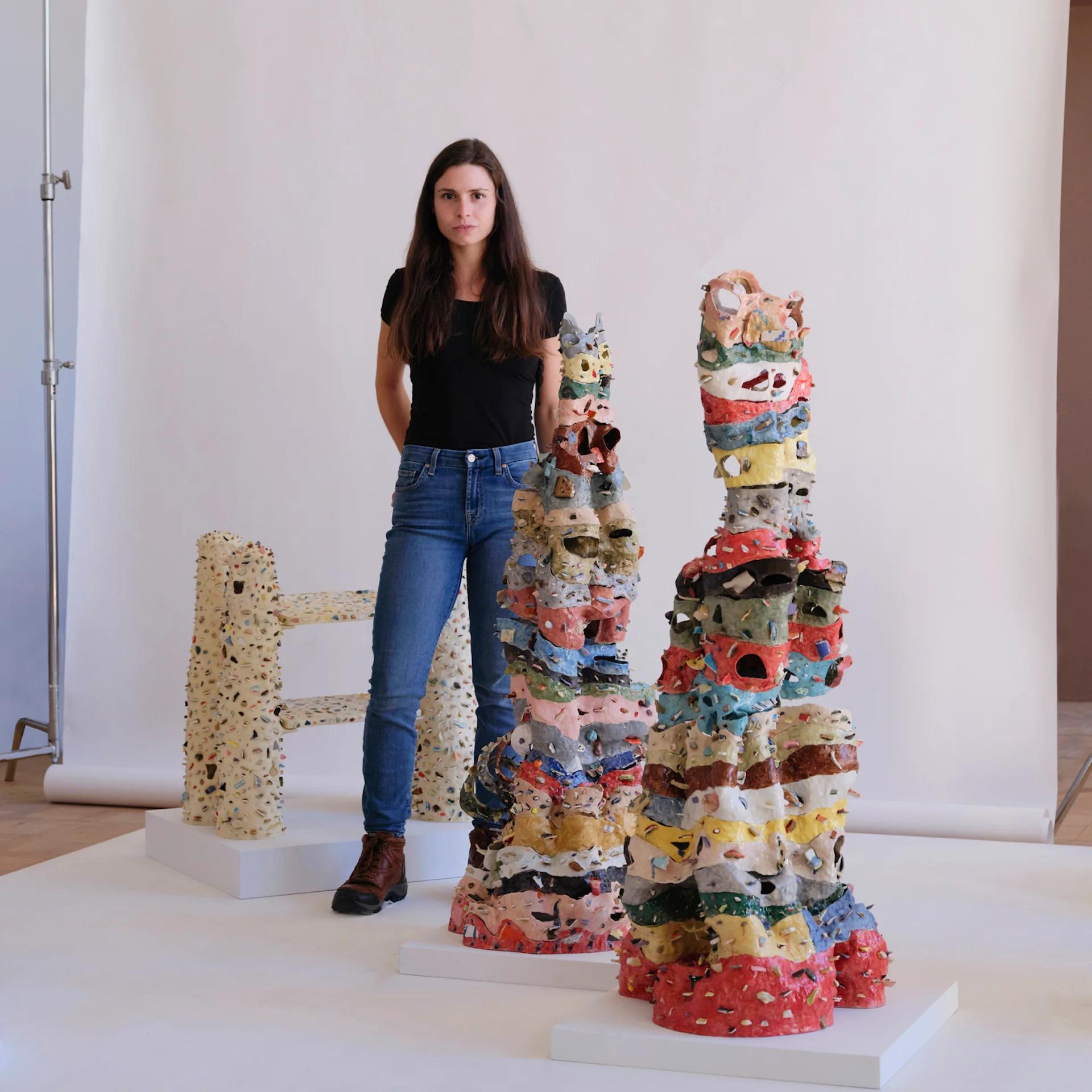
ISABELLA MAROON
Photo © Carpenters Workshop Gallery
Isabella Maroon: In PartsWhile pursuing her MFA at the prestigious Cranbrook Academy of Art, Colorado-based ceramicist Isabella Maroon had a moment of clarity and completely transformed the focus of her practice from figurative to abstract work. Recognizing that this pivot represented a shift in her personal identity, she began smashing old works into shards that could find a second life in new pieces.
With her In Parts collection, Maroon builds upon her ongoing exploration of memory, destruction, and resurrection. Each form consists of stacked elements that are shaped separately over time and composed into a unified whole—the present and the past joined in homage to our ever-evolving identities.

TIARRA BELL
Photo © Carpenters Workshop Gallery
Tiarra Bell: Soul
Christianity is Tiarra Bell’s guiding light, both personally and professionally. Working primarily by hand in wood, the Philadelphia-born and based designer crafts functional objects that embody the noblest, most inspiring values of her faith—self reflection, redemption, and hope. Her chairs are not meant merely for rest but rather invite a meditative mindset. Her mirrors are not tools of vanity but instead prompt introspection on the state of one’s soul.
Bell’s Soul collection continues this mission, spreading the good word through a series of intricately crafted wood mirrors and lighting. These portal-like forms feature light-filled, James Turrell-esque centers that manifest the awe-inspiring power of God’s love.

ANUBHA SOOD
Photo © Carpenters Workshop Gallery
Anubha Sood: Between Salt & Water
India-born, New York-based textile artist Anubha Sood’s experimental practice is devoted to the study of bio-materials, from bacteria and human hair to her latest passion, seagrasses. Having witnessed the environmental and social toll exacted by the textile industry in her native India, Sood’s work critiques current production systems while visualizing a more equitable, sustainable path forward. At the same time, she sees the intuitive act of making as a personal healing process and a catalyst to physically engage with her environment.
Woven in kelp, linen, cotton, and rayon yarn, Sood’s Between Salt & Water collection draws attention to the decline of kelp forests and their role in maintaining Earth’s ecological balance. The pieces are both hand-crafted sculptural objects of contemplation and living entities that will evolve with the passage of time. The seaweed responds directly to its environment; when exposed to air, it produces salt crystals on its surface that absorb humidity and prevent it from drying. “The works, like our own bodies, are in constant flux, responding to the conditions of their immediate environment,” Sood explains. Further, their “precarious nature acts as a reminder to attend to our water and land with urgency and care.”
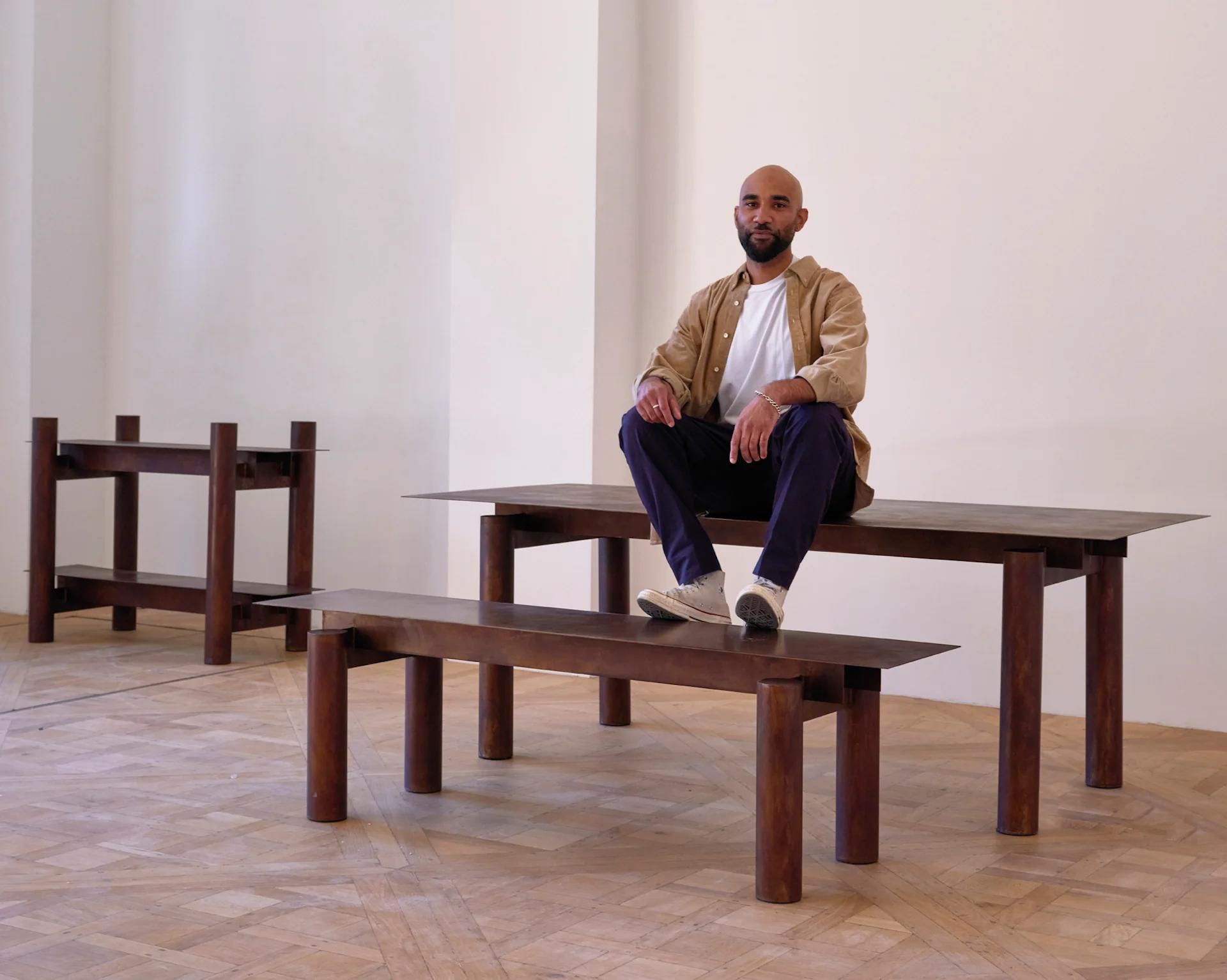
JEROME BYRON
Photo © Carpenters Workshop Gallery
Jerome Byron: Patina
Born in New York, raised in Ohio, and currently based in Los Angeles, architect-designer Jerome Byron is fascinated by the everyday, industrial materials that make up the American built environment. Through his practice, he elevates the humble and pedestrian—plywood, concrete, and sheet metal, for example—in highly considered, richly resolved structures, interiors, and objects. Alongside his natural aptitude for proportional composition, he has cited both his architectural education and his time spent skateboarding as key experiences that inform his approach to material, form, and movement.
Byron’s Patina collection explores surface treatments on steel forms through processes that represent controlled destruction. A range of skin tones, so to speak, are achieved by coating the metal in corrosive substances and then chemically sealing the effect against further transformation. The collection highlights Byron’s ongoing exploration of cultural pressures in contemporary life as well as his admiration for the elegantly economical geometries of Italian designers of the 1970s, like Vico Magistretti and Angelo Mangiarotti.

SUSANNAH WEAVER
Photo © Carpenters Workshop Gallery
Susannah Weaver: Memetic
Born in North Carolina and based in NYC, Susannah Weaver’s design practice is driven by material experimentation, in the great tradition of American modernist icons like Charles Eames and Marcel Breuer. Even so, as she explores the practical and poetic potential of wedding wool with concrete (the latter, notably, the modernist architect’s preferred media), she levels a penetrating critique of 20th-century design culture: its domination by males; its obsession with industrial production that engendered the current environmental crises; its conviction that designs could be standardized and universally beneficial across communities and cultures while blocking diverse voices from contributing to the conversation.
Through minimalist, hand sculpted forms composed of two radically contrasting materials, Weaver’s Memetic collection asks us to reconcile our continued reverence for the legacy of mid-century American design while owning up to its problematic histories. The title suggests an astute way of seeing the world: Beliefs that survive aren't necessarily true; rules that survive aren't necessarily fair. In Weaver’s hands, the sharp edges of bygone brutalism are literally softened, both tactilely and visually, by the insubordinate grace of nature.
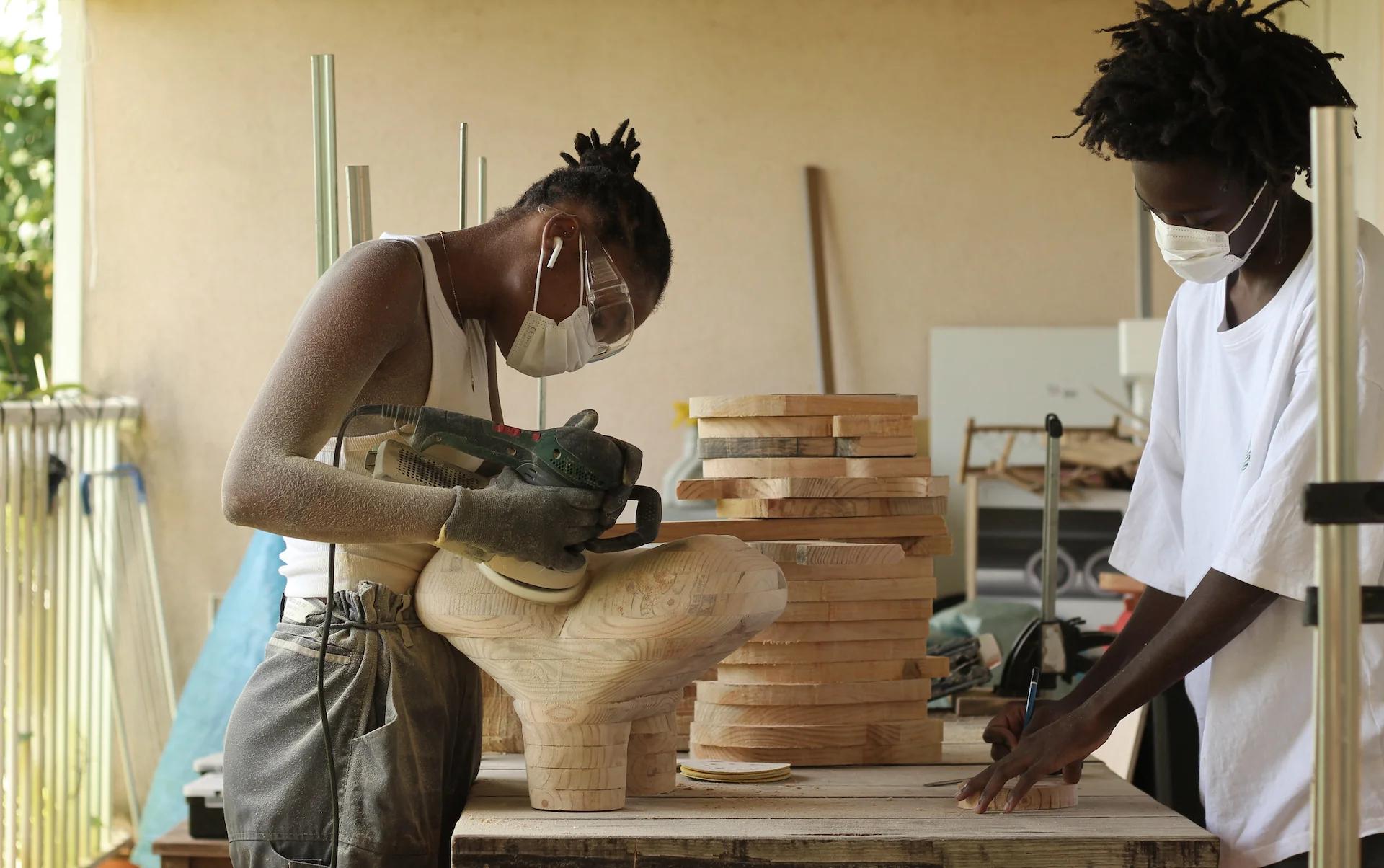
IBIYANΕ
Photo © Carpenters Workshop Gallery
Ibiyanε: Alè
From Cameroon and Martinique, Tania Doumbe Fines and Elodie Dérond of Ibiyanε named their design studio after the Batanga word meaning “to know one another.” Working primarily in wood, they sculpt objects for everyday use. Pure functionalism, however, is not the studio’s exclusive goal. Informed by exchanges in their everyday lives with family, friends, and community, their work elevates the role of storytelling in design, and in turn nurtures conversations that center the design canon on the heritage of the African diaspora.
Ibiyanε’s new Alè collection (meaning then/now in Creole) draws inspiration from the duo’s collective memories of family. Together, they envisioned a scene—a multigenerational house, its human inhabitants, its interior objects, and the relationships it hosted—set in Martinique, where they currently reside. The resulting hand-carved wood seats evoke both the legacy of Wendell Castle and the distinct forms of Caribbean and Sub-Saharan woodwork.
